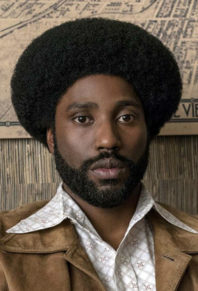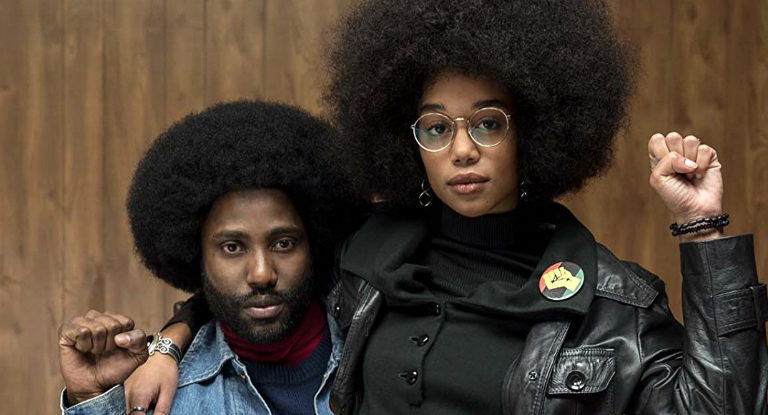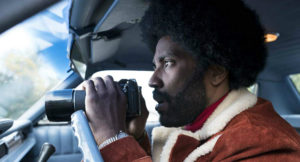
If Spike Lee isn’t the hardest working man in show business he must be the most ambitious. Over the last 30-years, Lee has worked on movies, commercials, music videos, video games, and a Netflix series. In an ideal world, no one film would define a director’s extensive career. But here’s the thing about Lee: he has a masterpiece under his belt. Do the Right Thing, the fourth entry into his massive body of work, remains his signature picture. Three decades later, people still want each new Spike Lee Joint to be the next Do the Right Thing. Whether or not you believe it can happen, Lee’s latest film, BlacKkKlansman, is at the very least, worthy of joining the conversation.
The politically-charged film presents a timely (and timeless) story about the racial divisions etched into America’s DNA. At once hilarious and horrifying, BlacKkKlansman is a gripping eye-opener that dives head-first into the murky waters of racial intolerance. With Lee’s slick directing style, two knockout performances, and lightening-rod subject matter, expect BlacKkKlansman to pop up in award season chatter later this year.
It’s the early 70’s, Nixon sits in office while America is at war, and Ron Stallworth (John David Washington) wants to make a difference. Stallworth joins the Colorado Springs Police Force and even though he’s overqualified for the job there’s one thing holding him back: He’s black. Being overqualified and all, Stallworth soon goes from his lame evidence room assignment to working undercover. When the higher-ups grow suspicious of Colorado College’s Black Student Union event they task Stallworth with infiltrating the gathering. Instead, working as a mole turns into an eye-opening experience.
The guest speaker and event’s organizer (Laura Harrier) level-up Stallworth’s wokeness and he returns to work bent on taking down the real threat to the American people, the KKK. The Klan has taken out ads in the local paper looking for recruits. Stallworth, with his lifetime of experience putting white people at ease, pretends to be white and talks his way into a meeting. He brings onboard fellow cop Flip Zimmerman (Adam Driver), who is also Jewish, to be his stand-in at face-to-face meetings. Together, they launch an unbelievable investigation involving secret initiations, bomb scares, and embarrassing the Klan’s head honcho, David Duke (Topher Grace).
BlacKkKlansman’s challenging material packs a strong emotional punch. And that the script’s themes are still relevant today adds some extra sting. Lee ends the film with horrific footage from last summer’s Unite the Right rally in Charlottesville. Despite loving the film those final images left me walking out of the theatre with my stomach in knots. And yet, BlacKkKlansman is extremely funny. Don’t be surprised to find yourself laughing all the way through. Lee’s best films have always elicited humour from the absurdity of racial tension. And having a dark-skinned, afro-wearing black man infiltrate the Klan and impress its leader? Sometimes the jokes write themselves.
BlacKkKlansman’s outlandish conceit is a comedic powder keg waiting for the slightest spark. But there’s another element intensifying every laugh-out-loud moment. This movie seeks to make viewers deeply uncomfortable. Lee employs clever juxtapositions, on-the-nose metaphors, and smart editing to make the audience squirm in their seats. He deftly draws parallels between the blatant racism of the 70’s to the subtler brand we endure today. Lee forces us to confront our own complicity. It’s in these moments where we search for anything to break the tension. It’s the same effect that makes humour so effective in horror movies; laughter becomes a respite from our unpleasant feelings. The beauty of the humour in BlacKkKlansman is that the jokes are as cathartic as they are clever.
Sad as it is to say, not every director and cinematographer has the know-how or the time to effectively photograph black people. (Start paying attention to how often films shoot scenes with black actors in unflattering lighting). The Ava DuVernays, Rachel Morrisons, and Barry Jenkins of the world take painstaking care to film darker-skinned actors as though they’re posing for the cover of Essence Magazine. Lee’s films have always revelled in black beauty. A lifelong cinephile, Lee grew up watching actors who look like him stuck playing thugs, junkies, and whores. There’s a place for those roles in Lee’s films, but their outweighed by his intelligent, attractive, and complex characters. Lee’s films are for everyone, but he takes extra care to nourish his black audience’s spirit. Visually, Lee’s films capture his dark-skinned actors with the beauty, strength, and elegance reserved for Beyoncé and Jay, preening at the Louvre.
Lee and his DOP Chayse Irvin (Beyoncé’s Lemonade), capture a memorable dance scene that isn’t essential to the plot. Men and women, all various shades of brown, dance the night away in a dimly lit bar. They line the room with precision and looseness, part Dora Milaje, part Soul Train line and “let the rhythm move them.” They shimmy, shake, and gyrate, the weight of the world off their overburdened shoulders, leaving a wallflower like myself wanting to get out of my seat and dance. It’s a tender and loving flourish in a film highlighting intolerance and depravity.
Another standout scene features the Black Student Union’s speaker Kwame Ture (Corey Hawkins channelling Denzel Washington channelling Malcolm X). Ture’s empowering speech leads to a pivotal moment for Stallworth. But Lee’s camera takes time to study the young people in the crowd. As Ture speaks, the lights fade to black, and the camera cuts to the student’s detached heads, floating in the darkness, their attention held raptly. This scene offers more than dynamic visual compositions. Black power activists have always been America’s boogeymen and this scene humanizes the movement. Listen in and Ture’s words prove why it’s wrong to conflate black power with white subordination.
Lee attacks enough issues to keep me here writing all night. One topic I must touch on, though, is how BlacKkKlansman comments on integration versus inclusivity. In these divisive times, we struggle with discussing racism because too many people see the issue as black and white… let me rephrase that. A binary issue. People are either Klansman-level evil or card-holding members of the 100% non-racist club (along with MLK and Mr. Rogers). Acts of racism and prejudice sit on a spectrum and Lee does an exceptional job of highlighting how black Americans navigate their way acround the many points.
Most of Stallworth’s co-workers don’t object to having a black man on the force. But that’s not the same as accepting him. A few antagonize him, most don’t bother with him, and no one embraces him as they would a white rookie. As the film goes on their relationship evolves but only after Stallworth does the near-impossible. Stallworth earns his co-workers respect after pulling off a superhuman feat of police work. Had he remained in the evidence room he would have stayed, “that black guy down in the basement.” In America, black, white, Latinx, First Nations, and Asians rub shoulders every day but that’s not the same as getting along. BlacKkKlansman shows us the difference.
Spike Lee is at a point in his career where he gives no f#<ks – you could argue this has always been the case – and he’s a better filmmaker for it. Lee’s outstanding body of work earned him the clout to focus on bold, challenging, and personal projects. It’s impossible to imagine a picture better suited to Lee’s distinctive voice and creative vision. BlacKkKlansman pulls no punches as it pummels notions of white superiority out of existence while calling out America’s half-assed march towards racial equality.
This picture, an earth-shaking thunderbolt of wokeness, could easily come across as bitter medicine. But Lee’s masterful touch makes eating our vegetables tastes like candy. His expert use of levity keeps BlacKkKlansman feeling lighter than it has any right to. Comical, incisive, and affecting, BlacKkKlansman inspires the heart, challenges the mind, and galvanizes the spirit.
- Release Date: 8/10/2018




